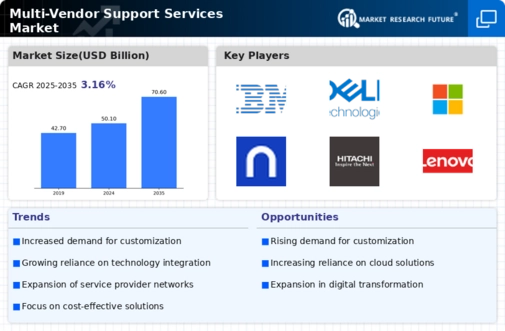Focus on Cost Efficiency
Cost efficiency remains a pivotal driver in the Global Multi-Vendor Support Services Market Industry. Organizations are continually seeking ways to streamline operations and reduce expenses associated with IT support. By leveraging multi-vendor support services, companies can consolidate their vendor management processes, potentially leading to significant cost savings. The market's anticipated growth to 70.6 USD Billion by 2035 indicates that businesses recognize the value of these services in achieving operational efficiencies. Furthermore, the ability to negotiate better service agreements with multiple vendors enhances financial flexibility, making multi-vendor support an attractive proposition for organizations aiming to optimize their IT budgets.
Market Growth Projections
The Global Multi-Vendor Support Services Market Industry is poised for substantial growth, with projections indicating a market value of 50.1 USD Billion in 2024 and an anticipated increase to 70.6 USD Billion by 2035. This growth trajectory is supported by a compound annual growth rate of 3.17% from 2025 to 2035. The increasing complexity of IT environments, coupled with the demand for cost-effective solutions, is likely to drive this expansion. Organizations are recognizing the strategic advantages of multi-vendor support services, which can enhance operational efficiency and adaptability in a rapidly evolving technological landscape.
Emergence of Cloud-Based Solutions
The emergence of cloud-based solutions is reshaping the Global Multi-Vendor Support Services Market Industry. As organizations migrate to cloud environments, the need for support services that can manage multi-cloud strategies becomes essential. Multi-vendor support services facilitate the integration and management of various cloud platforms, ensuring seamless operations. This shift is indicative of the broader trend towards digital transformation, which is expected to drive market growth. The increasing reliance on cloud technologies suggests that businesses will require robust support frameworks to optimize their cloud investments and ensure operational continuity across diverse vendor ecosystems.
Increased Complexity of IT Environments
The complexity of modern IT environments is a significant driver for the Global Multi-Vendor Support Services Market Industry. As organizations adopt a myriad of technologies, including cloud computing, IoT, and AI, the need for specialized support services becomes increasingly critical. Multi-vendor support services provide the expertise required to manage these diverse technologies effectively. This complexity is reflected in the projected CAGR of 3.17% from 2025 to 2035, suggesting that as technology evolves, so too will the demand for tailored support solutions. Organizations are recognizing that a multi-vendor approach can enhance their operational resilience and adaptability in a rapidly changing technological landscape.
Regulatory Compliance and Risk Management
Regulatory compliance and risk management are becoming increasingly vital in the Global Multi-Vendor Support Services Market Industry. Organizations face a myriad of regulations that govern data security, privacy, and operational integrity. Multi-vendor support services can assist companies in navigating these complex regulatory landscapes by providing the necessary expertise and resources. As businesses strive to maintain compliance and mitigate risks, the demand for these services is likely to grow. This trend is particularly relevant in sectors such as finance and healthcare, where regulatory scrutiny is intense. The ability to manage compliance across multiple vendors enhances overall risk management strategies.
Growing Demand for IT Infrastructure Management
The Global Multi-Vendor Support Services Market Industry is experiencing a surge in demand for comprehensive IT infrastructure management solutions. Organizations are increasingly reliant on diverse technology ecosystems, necessitating support services that can seamlessly integrate various vendors. This trend is underscored by the projected market value of 50.1 USD Billion in 2024, reflecting a robust growth trajectory. Companies are seeking to optimize their IT operations, reduce downtime, and enhance service delivery, which is driving the adoption of multi-vendor support services. As businesses expand their digital footprints, the need for effective management of multi-vendor environments becomes paramount.










